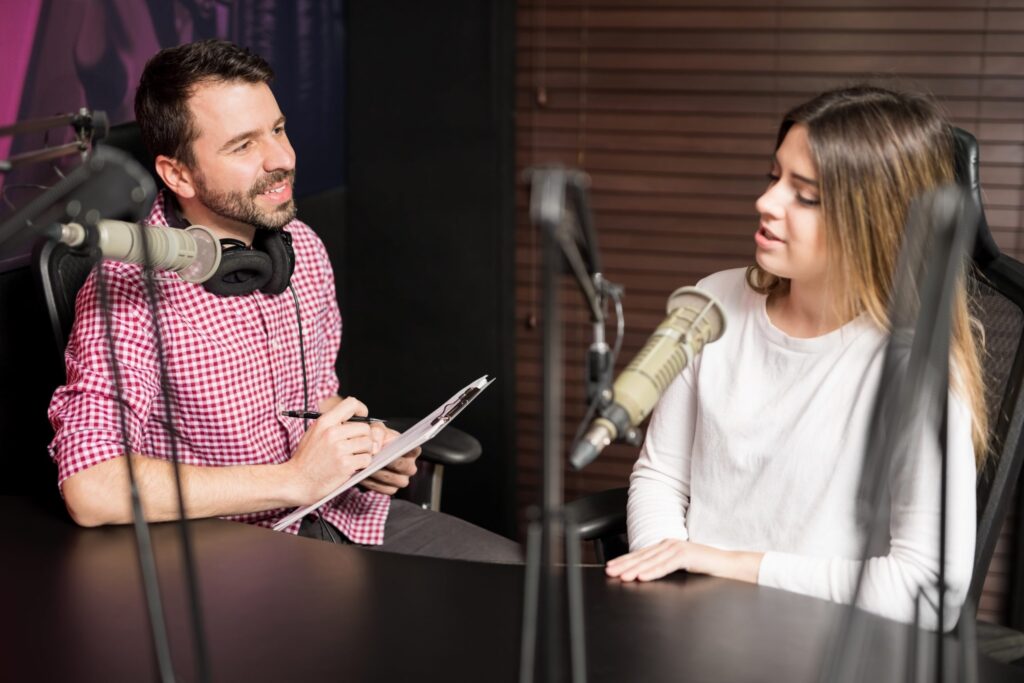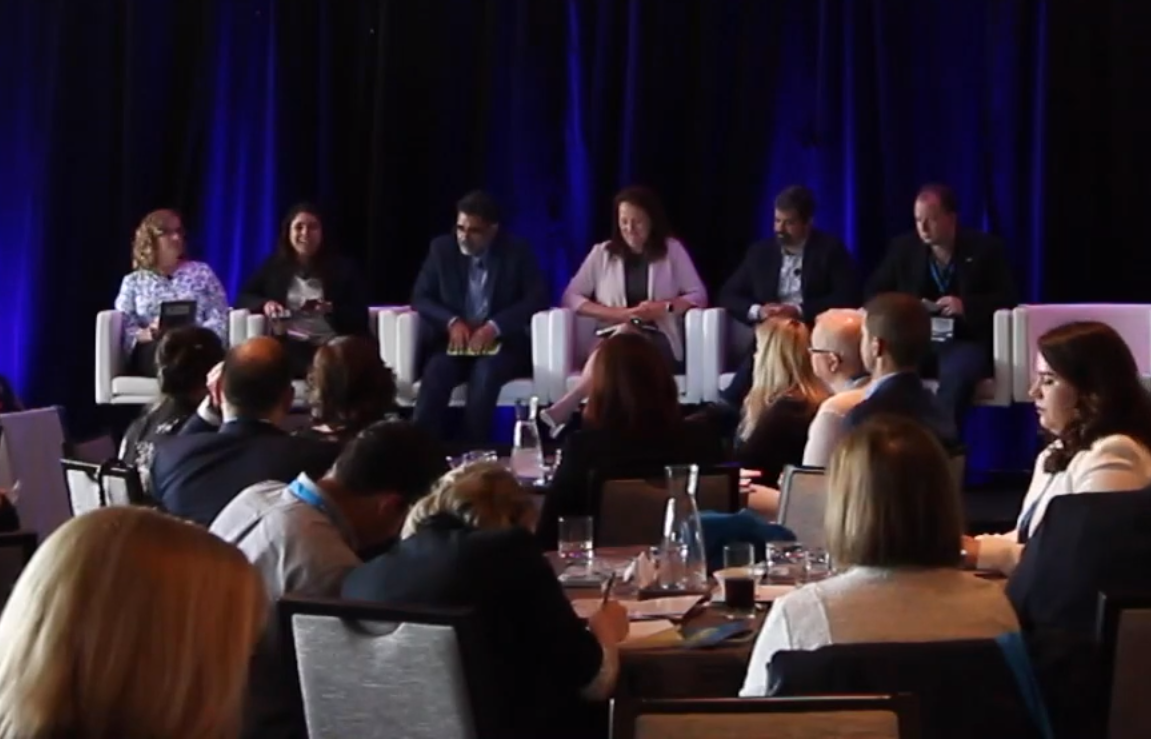Shawnna Sumaoang: Hi, and welcome to the Sales Enablement PRO podcast, I’m Shawnna Sumaoang. Sales enablement is a constantly evolving space, and we’re here to help professionals stay up to date on the latest trends and best practices so that they can be more effective in their jobs.
Today, I’m excited to have Kathryn Frankson from Informa join us. Kathryn, I’d love for you to introduce yourself, your role, and your organization to our audience.
Kathryn Frankson: Yeah. Hi Shawnna, thanks so much for having me on. I am the Director of Event Marketing at Informa, and Informa is a global events and intelligence company. We produce conferences, trade shows, user conferences, sales events all around the world in a variety of markets. We’ve also got content that we sell, white papers that we produce. It’s a very interesting time to be in this industry. I oversee all of our event marketing, but my background is actually in sales.
SS: Well, thank you so much for joining us today. Now, your experience developing events for virtual, hybrid, and in-person environments is also something that I think a lot of sales enablement practitioners are deeply involved in within their organizations, particularly when it comes to things like their sales kickoff events or any quarterly events or maybe president’s club.
As many sales practitioners are responsible for events for sales teams, I’d love to understand from you, what are some of the different factors that you need to take into consideration for each of those different types of event environments?
KF: Yeah. All of our events, pre COVID world were physical events. We were exactly living in that, so field events, what are we handling for sponsorship and lead generation, audience acquisition, major conference and trade show production. I feel like it’s a great question because the different factors are front and center more than they ever have been. There was a lot of getting into our routine of events and going, great, this is how our enablement conference went last year, so we’re going to lift and shift it again. When everything stopped and we made the shift to virtual, new questions were right at the forefront.
For us, the three biggest factors when you’re planning a virtual event specifically is one, the product that you’re actually creating. I say to our team, congratulations, you are product marketers now. We have a lot of specialists, but if we’re not using the right insights that we need to create an in-demand product that the market has acceptance and a level of aptitude for, then you’re going to start doing all of your channel work and you’re going to have your goals and your audience acquisition or your KPIs around how many leads you want to feel to your reps, but you’re not going to get there because the actual product that you’ve created isn’t in alignment with where your audience is right now.
Taking that quintessential step back and going, what is the right? What is the right format? What is the right timing? What is the right length of time? How hyper-specific do we have to get in terms of niching down? One of the things that we’ve seen more success in is going into persona-heavy, themed, highly targeted, more niche events. It speaks to your audience in a deeper way.
You also really need to think about price or objective. We do run paid events as well, so when you think of that pricing model, are you doing audience acquisition, free events leading up to something that might have a price point attached to it? If your objective is just lead generation, brand health, brand reach, and awareness, then you have to go in with that because there’s no way to build similar programming out like you had in past years without it stemming from the objective that you really have to hit.
Then the other big factor is promotion. We’re usually working on a tighter promotion cycle for virtual events, which I think is opportunistic in many ways, but you definitely can be out sprinting really, really quick. How we’ve managed that is marketing plans that are a little bit pithier but have your macro plan. Here’s our audience, we need to achieve X. This is where we’re going. Here are our benchmarks. It doesn’t have to be so fully baked from channel strategy end to end because that’s going to take a little bit too much time, but then that leaves room for all of your micro strategies. As we go along, we might pop up into a clubhouse room or we’re seeing some success here so we’re going to lean into that a little bit more. That just allows you to move faster.
Virtually that’s how we’ve been planning for those events, which we’re still doing a lot of. We are starting to think about physical events again. It’s going to really depend on the regionality, your audience, what your goals are there. That move into in-person, the considerations are very different. Market support, safety, location, budget, data. We’re probably going to see a heavy regional focus, so does our own data that we have support this from an attendance perspective? Does this make sense financially? If we need more space with these safety protocols and we’re capped in some ways, does it feel viable? Are we actually achieving our goals that we need to successfully with our virtual events? The considerations become very different.
Then of course, for hybrid, there is an intersection point between both of those, but it becomes a little bit more nuanced even when you get into the production of we’re going to design an experience for a virtual audience and then for an in-person audience as well.
SS: I couldn’t agree more. You actually touched on a few of these already in that response, but just to really focus on this, what are some of the key challenges that you encountered in the past with the shift to primarily virtual events? What are some ways in which you can overcome some of those challenges?
KF: It’s interesting, we uncovered all of the challenges as we were doing our events. Content translates really well, so challenges were sponsor and exhibitor inclusion, getting that formula right. Building out partnerships that made more sense, were in better alignment, they felt like they were getting the return that they wanted. Audience acquisition, how do we get the attendance that we want on our events? Also, how do we onboard them appropriately?
There was certainly a lot of new technology, and when you think of what makes this successful is if we feel like we’ve got all the right building blocks, but we need to have this level of attendance, this performance makes it viable for either our sales team or our sponsor or just us as an event. This is the lift that we’re hoping to achieve from it.
Then, making sure that you’re solving for engagement because if you do get your audience, many of them who might be super fans of your brand or alumni or key partners, if you get them on and it feels like there’s a lag or a drag and there isn’t the engagement that they want, you certainly don’t want it to be something that actually becomes a disincentive for partnerships.
The ways around that, some of it was flying the plane while you’re building it, so a lot of information sharing. We had a slack channel where it was really tight communication from our sales enablement, from marketing, from ops, from content, so that everyone is on the same page with the type of feedback that we’re getting. I think it was really important. One of the goals of our team was to make sure people were speaking, exhibiting, partnering at other events so that you can get this level of empathy and understanding for the new production and design. What’s working? What is your attention span for the event? If we sponsor, we’re an exhibitor, so how does that feel?
Getting all the right inputs and communication sharing throughout the process really made a big difference because then you’re just able to be honest, course-correct, iterate, and at your next event or your next virtual field event, you’re just that much tighter in your execution.
SS: Absolutely. Now, you hit on a very keyword there, and that was empathy. You’ve said before that empathy is extremely important when it comes to the audience and what and how they’re experiencing things.
Why is that important? What are some ways that practitioners can build on that empathy?
KF: Yeah. Your event isn’t going to feel right if you don’t plan it with empathy. It’s going to feel a little tone-deaf, and you don’t want to go to market with that same messaging, which is easier said than done. There’s a lot of new moving parts and some teams are working leaner, some people in the tech space are busier than ever and they’re scaling, so it’s a really unique time to be producing this new volume of virtual events, but you really have to.
You’re iterating, your revenue models are changing, but without that pause and saying, we have to rethink what our value prop is. What’s actually going to land? What copy are we using? How are we positioning? Are we being really honest with what’s going to be valuable for our audience? If you don’t lead with that level of consciousness and you just go, here’s the plan, we’re going to open registration, we’re going to announce this, here’s our key milestones that we that we want to hit, it’s going to really feel like there’s a disconnect with your audience.
Some of the areas that we found that we needed to take a really empathetic approach was with technology. Virtual events have scaled, so the comfort level of your audiences and your partners and your speakers is there in a much more profound way, but helping your audiences get into the event, being really clear about tech preferences, holding their hand in new ways, sending the right volume of reminders and being really realistic about what the hurdles are for them to join.
We took the approach where we wanted to audit all of our communications. Nothing was rinse and repeat. Almost to the point where you’re thinking, okay, if I am getting this message, I’m working in this sector, I’m home, I’m really busy, I’ve got kids, I’m in my socks, is it going to feel right? Is it what they’re going through in their day to day at work? Are we capturing their attention? Are we making it as easy as possible to opt in?
One quick note was normally we thought, gosh, if you send five reminders a day, that would be really obnoxious. Turns out to be helpful. Everyone’s hopping on, they’re hopping off. They don’t actually want to miss a keynote, then they’re going to tackle something else, then maybe they do want to pop back in for the round table.
When you lead with that, your business outcomes are still right there, but I think it just sets the right tone because all of the communication that you’re sending out around your event and has just evolved so seismically end to end, both from promotions, to confirmations, how they access survey follow-ups, and where you take them on the journey from there.
SS: I love that. I think that that’s fantastic advice on how to incorporate empathy into audience building. One other thing that you wrote that really caught my eyes, you wrote about the importance of using the first minute of your event thoughtfully.
I’d love for you to explain that concept to our audience, and what are some common mistakes to avoid when it comes to that first minute? How can practitioners instead really leverage it to grab the attention of the audience?
KF: Yeah. I think that this feeds back into the empathy piece too. Previously, when you went to a physical event, you often travel, you’re on a plane, you’re flying somewhere, you’re excited, you’ve packed a bag, you’ve checked into the hotel, your lanyard is on. It’s. immersive. It’s very, very different. When you’re watching a virtual event, even if you’re excited, you’ve got your laptop on, you’ve got your event going in one browser tab, maybe have LinkedIn open in another, your outlook, your Gmail, you’ve got your phone in your lap, you’re at home, there’s an Amazon delivery. All of that doesn’t mean that you’re not eager to participate, to get this content, but you don’t have that immersion that anyone creating event experiences before benefited from. You have to grip your audience right away, provide them value right away, or you’re going to lose them to all of these other incoming messages that they have.
No one is going okay, I’m going to watch this, I’m going to shut down absolutely everything else, I’m going to go totally into a quiet room. It’s just not realistic. You’ve put all of this hard work into getting however many people on this event, and that’s where you have to activate it. If you get them, if you grip them right away, you’re hooking your audience.
A lot of the mistakes that I see being made is the event opens up, maybe you’ve got the holding slide, which is fine, sometimes events will start a few minutes late because they’re still getting some tech rolling on the back end, which is understandable, although that margin for error is getting tighter and tighter. Then it’s housekeeping slides. You’re going into this long thing you’re doing really long intros, maybe your CEO wants to say hello. That can all feel right as rain. That might’ve been how things were formulated in your physical event, but you don’t have that benefit of a captive audience.
You have to dive right in and then you bake any of those components in later, if you really do feel like you have to include them. A lot of them I would argue you don’t have to but bake them in later because then you’ve got your audience invested.
Some easy examples, one, have a really great moderator. Have them diving in right away. We found that depending on the size and scale of your event, networking can be a little bit tougher, but people love chat. Diving right into chat. “I see we’ve got Katherine from Minneapolis.” Engage your audience, have something really visually stimulating, have some banter with your guests.
I saw a virtual event yesterday actually that was really great. They were talking about what was hot in events, event trends. They pulled this from a TV concept, which I think is great, but the panelists did it while they were eating wings with hot sauce. Right as it started, their wings were delivered, it felt a little bit like TV. You were engaged. Where are they? Where are they going? They’re actually leaving, oh, they’re coming back with the wings. They’re putting the sauce on. I would imagine the audience attendance that stayed on through that event, mainly because it was so captivating right from the onset was high.
It doesn’t have to be something that’s costly, it doesn’t have to have production value. All you have to think about is great, we’ve done a ton of hard work to get our audience here, if we challenge ourselves, we’ve got one minute to make sure that they feel like this is how they want to spend the next hour or half-day or a day. Put that healthy pressure on yourself and think of something that would be visually attention-grabbing. You’re going to have people joining just with audio as well, so think about something that would be really entertaining to listen to, and just dive right in. Then build in some of those components that might feel like you’re easing a little bit into your event later on.
SS: Absolutely. I love that. I love that you’re always challenging the status quo with your virtual events. I think that’s really important because you and I have talked about this a few times now, but there is a lot of fatigue, especially virtually. How can you help maintain that high energy and that momentum throughout a virtual event?
KF: Well, I think you have to also decide that you want to have a high-energy virtual event. A lot of this is a mindset that leads to execution. Some of making sure that it is high energy is doing less. It’s going gosh, did we overproduce our last day? We wanted to provide so much value in so many sessions and content and interactivity and channel choices or room choices. Was that maybe too much? What if we do this one thing more condensed. One great speaker here. An experiential element. Let’s kick up the design factor a little bit, challenge our designer to just do something really fun and let’s go all-in on that.
It’s also the willingness of your team to have those conversations and also not romanticize what you’ve already done. We’re all learning, it’s changing for everyone, and there is success in every event that you’re producing. Pat yourself on the back and then go, how do we freshen it up? Less of, oh, that works so we can do one of these a month. More saying, that worked, excellent. We checked the box and now we’re going to really do something and try to try to level up. Or, we went to another event, this worked well for them. Let’s borrow that, let’s use that format.
There’s also a lot of inspiration out there, so it doesn’t have to feel like reinventing the wheel every time, but I think having that right mindset of your team, keeping everyone excited about that process too will also keep it from feeling a little bit fatiguing even internally as well.
SS: I could not agree more having done a few of these virtual events. It’s important not to get complacent.
Now, this has been a fantastic conversation, I’ve learned so much. I do want to close this out a little bit because I think, and you’ve written about this as well, it is really important to give audiences the opportunity to create things together, not even just learning together during these events. What are some ways in which our audience, our sales enablement practitioners can cultivate meaningful experiences during events?
KF: Yeah. Creating together I do think is the next opportunity for events. We’ve scaled free content really well and I think we’ve now taught our audiences that we are going to be doing really smart, specific, interesting events. People are available to speak more than ever, we’re getting really good thought leaders, but the next layer to peel back in the onion is the value exchange for my time, what am I getting out of it? Especially if our audiences can just watch something on demand. If you know that you’re opting into something and you’re able to create together, leave with a level of work product together, that can really shift how they feel about what you’re building for them.
Some of the execution that we’ve seen work really well is virtual breakouts, round tables, sponsored sessions. Sponsored content works really well too. We’ve seen this decoupling of church and state, or we do pure editorial content and speakers from the industry, and then we’ve got suppliers. Your suppliers are thought leaders, so integrate that. They may lead a working session as well. If you’re in the tech space, maybe we’re going to bring them together. They’re going to do demos. We know you’re solving for these problems, and you have questions, we’re going to walk through it together.
Maybe you’re in the marketing space, we’re going to do some website teardowns. We’re going to actually show you how we would build landing pages. We’re going to do a screen share and walk you through how we think of our sales funnel or our marketing plans. Here’s an actual example of how we’re scheduling out our content.
That moving into the really tactical “how” is what your audience wants, and they will opt in for that. That feels like the piece that they’re waiting for. I think too, virtual does still offer that. We had a partner event where it was in the sustainability space and they did a virtual a virtual tour of a biochar field in Helsinki, very scientific. In the site, it took them in, showed them how it was planted and how it’s a soil amendment, all of that. The reality is no one on that call would have had that experience without that event. Then putting everyone into breakouts and saying, okay great, we know there’s this new level of funding coming in nationally. How are you building that into your plans? Then working through some of that and your net promoter scores go through the roof.
There’s a lot of ways. It’s being really close to your audience, understanding what they would want, thinking creatively. It doesn’t have to be a super heavy lift. It can feel like, oh my gosh, they have to bake something together, as opposed to, we’re just hiring a speaker and they’ll present and that’ll be great. Audiences and partners and sponsors are responding so well to that, and it’s really valuable.
SS: I love that. Kathryn, thank you so much for the time today, I appreciate it.
KF: Thank you, Shawnna, I appreciate it too.
SS: To our audience, thanks for listening. For more insights, tips, and expertise from sales enablement leaders, visit salesenablement.pro. If there’s something you’d like to share or a topic you’d like to learn more about, please let us know. We’d love to hear from you.







